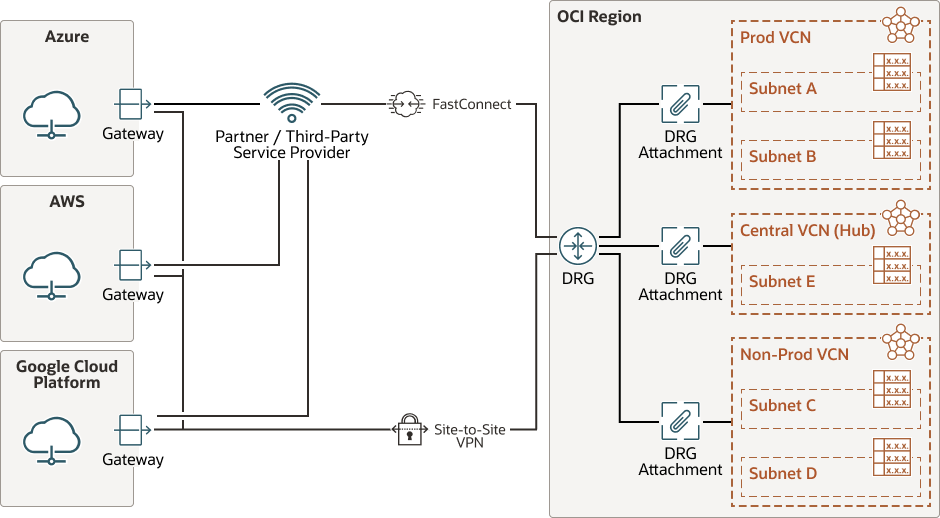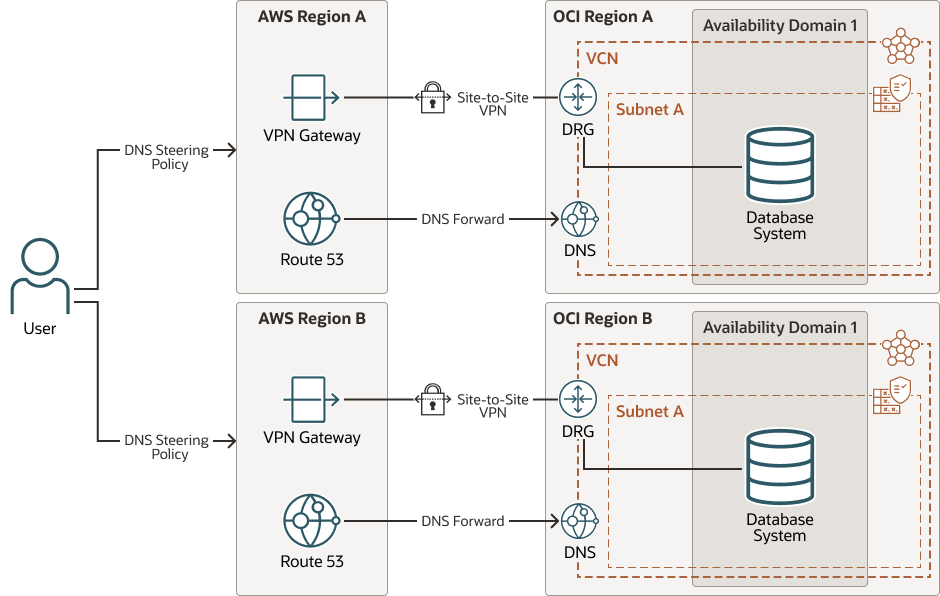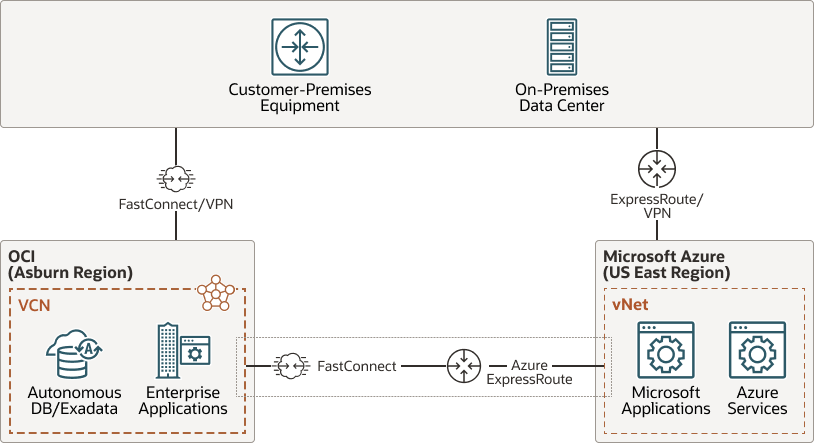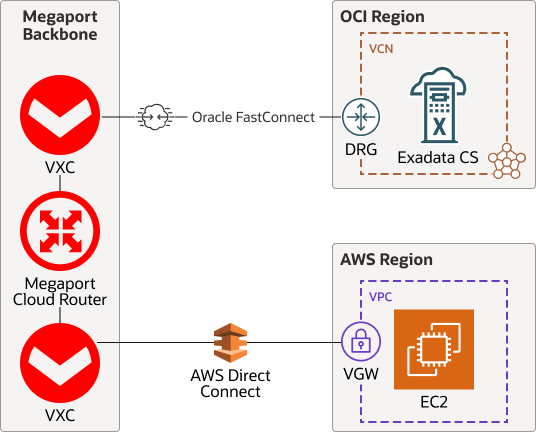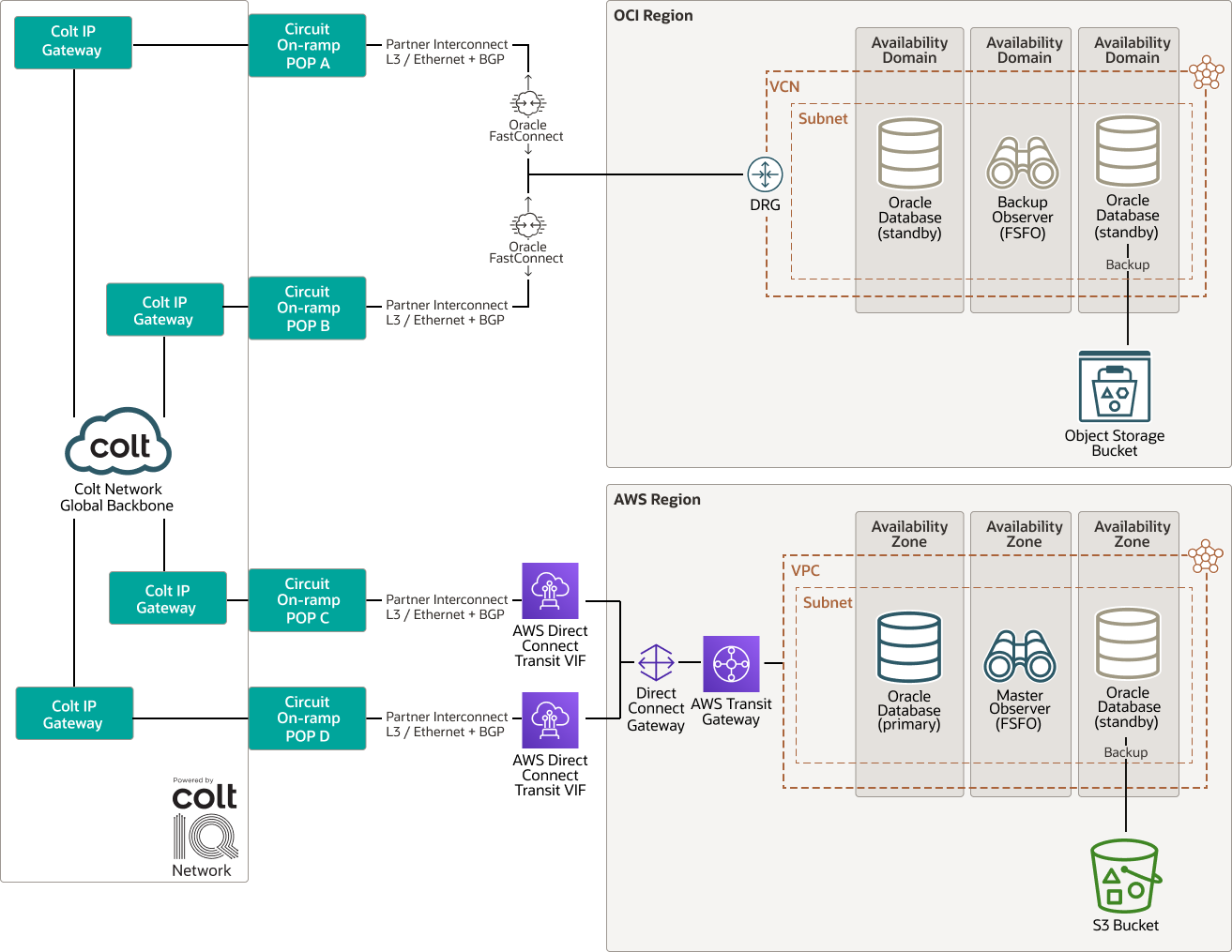About Cloud Network Access
The private cloud network access includes these components: IPSec VPN, FastConnect, Interconnect, and DNS.
The following diagram shows multicloud connectivity:
cloud-access-multicloud-connectivity-oracle.zip
For multicloud connectivity in OCI, you can use a site-to-site virtual private network (VPN) to connect to another cloud. These connections are generally over the internet and come with encrypted tunnels to provide security. However, lower latency and high bandwidth are difficult to achieve when using VPN connectivity.
Use an OCI dedicated connection in situations where you have fixed bandwidth and very low latency. The FastConnect service is vital when you're running applications across clouds as low latency can be key for a split-stack application architecture.
Site-to-site VPN has the following features:
- Uses the internet as carrier (can use FastConnect as well)
- Bandwidth/latency can vary
- Can have redundant tunnels (Recommended)
FastConnect has the following features:
- Uses a dedicated connection
- Fixed bandwidth/latency
- Can have redundant tunnels (Recommended)
The following diagram shows an example of DNS in multicloud:
cloud-access-dns-multicloud-oracle.zip
Domain name system (DNS) is a critical component for accessing applications and is a key consideration in a multicloud application architecture design. The time needed to resolve application names in multicloud drives user experience. OCI provides options to either host the DNS as primary provider or be able to integrate with other cloud providers DNS services. For example, you can have a Route 53 AWS DNS service steer traffic between the two OCI regions where the application is deployed for production in one OCI region and DR in another.
The following are a few things to keep in mind:
- Define the multicloud DNS architecture to assess the impact of the DNS resolution time on the overall application performance or user experience.
- When a DNS request is performed, unless the DNS resolver has already received and cached the request, the DNS resolution process will take time. It is critical to set up mechanisms that provide the lowest latency.
About Oracle Interconnect for Azure
The following diagram shows an Oracle Interconnect for Azure architecture:
cloud-access-azure-oci-interconnect-oracle.zip
Oracle has a strategic partnership with Microsoft to provide you with true multicloud options to choose from. Oracle Interconnect for Azure provides a direct connectivity between the two cloud that is managed and provisioned by your organization. You can choose the best services from each cloud provider to build multicloud solution architectures. Under the hood for this service is OCI FastConnect and Azure ExpressRoute, which provides very low latency and high bandwidths. For example, you can use Azure Synapse Analytics with a large data warehouse in Oracle Exadata Database Service.
- With Oracle Interconnect for Azure, you can migrate and run mission-critical enterprise workloads across clouds.
- FastConnect and Azure ExpressRoute provide a direct connection with low millisecond latency and no requirement for an intermediate service provider.
About Oracle Interconnect for Google Cloud
Oracle Interconnect for Google Cloud directly connects OCI and Google Cloud in 11 commercial regions globally. With Oracle Interconnect for Google Cloud, Oracle and Google have created an integrated cloud experience using OCI FastConnect and Google Cloud Interconnect. This multicloud interconnection allows you to run mission-critical enterprise workloads across your Google Cloud and OCI environments and access the best-in-class services of each cloud provider, over private, low-latency connections with no data transfer fees.
The following diagram shows you interconnect between OCI and Google Cloud with Oracle Interconnect for Google Cloud:
About Connectivity Partners
The following diagrams show a few of our largest connectivity partners: Equinix, Megaport, and Colt:
GUID-DE721197-95EF-4DC6-AC12-70A983983C18
connect-public-cloud-oci-aws-oracle.zip
GUID-29B33F2C-3FF7-4423-95CA-A6DA8A9A90A1
OCI has a strong partnership with a number of connectivity service providers globally. These services providers have cloud connectivity features that allow multiple cloud service providers to connect for building multicloud solution architectures. Oracle partners with global cloud connectivity providers like Equinix, Megaport, and Colt. A simple configuration option within the OCI Console allows you to establish these connections easily and provides the flexibility to deploy your applications by selecting the best service from each CSP. OCI's FastConnect partners allow you to quickly and easily establish connections from OCI to other clouds.
